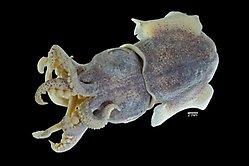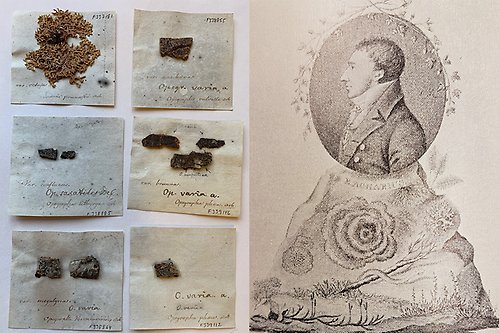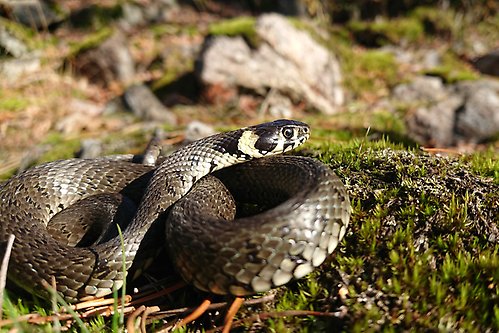Mollusca
The mollusc collections include mainly dry and alcohol preserved specimens, but also some microscopic slides. Marine molluscs from Arctic, Antarctic, North Atlantic and southern South America are particularly well represented in the collections. Regarding terrestrial and freshwater species, coverage is good for the Baltic Sea region and very good for Scandinavia.
 Zoom image
Zoom imageSquid Semirossia patagonica.
The alcohol collections have been catalogued on index cards, by species and catalogue number, respectively.
The image shows the squid Semirossia patagonica, which is only a few centimeters long. Photographer is Anna Persson, Swedish Museum of Natural History.

The dry collections of molluscs are largely not catalogued.
Roundworms – nematodes
We have a large older collection of microscopic slides of mostly marine nematodes from C.A. Allgén's work. The animals have been described in publications dating from 1925 to 1960. A large number of type specimens has been separated from the collection and digitised. However, the slides are in poor to very poor condition due to desiccation.
A more recent collection from Margareta Hendelberg's work includes marine nematodes collected at the Swedish west coast and in Norway, off Bergen and in the Trondheim fjord, in the 1970's.
Comparatively large collections of terrestrial species are also present, mostly from Swedish localities but also from Antarctica, prepared by Sven Boström and Björn Sohlenius.
Water bears – tardigrades
We have microscopic slides with specimens collected by G. Thulin. More recent slides of tardigrades collected by Björn Sohlenius contain specimens from Swedish coniferous forests in Gästrikland, from Stockholm's Royal National City Park and from the Stordalen Mire (Abisko).
The collections include tardigrades from Antarctic nunataks, collected by three Swedish expeditions (SWEDARP) during 1991–1997.
Bristle worms – polychaetes
A large number of polychaetes are present in the collections, all alcohol-preserved. The collections are based on material from collecting expeditions, the oldest from the early 19th century, and on private donations.
The type material includes species described by Kinberg, Malmgren, Hessle, Bergström, Wesenberg-Lund, Arwidsson, Hartman, Sigvaldadottir and Pleijel, among others.
Flatworms – platyhelminthes
In the early 20th century, several Swedish zoologists specialised in free-living flatworms, and large parts of their collections have been deposited at the Swedish Museum of Natural History. Among the most active flatworm specialists was Einar Westblad, who collected in the Nordic countries, on the British Iles and in the Mediterranean Sea, and Tor G. Karling, who collected mainly in the Nordic countries and in the USA.
Our collections also include a considerable part of all free-living flatworms collected in South America by Ernst Marcus, material from Antarctica collected by the Swedish South Polar expedition (1901–1903), as well as material from the Pacific Ocean by Sixten Bock.
Echinoderms
These collections contain mostly older material from the 19th and early 20th centuries, collected during several large expeditions to mainly Nordic, Arctic and South American areas.
All five living groups of echinoderms (sea lilies and feather stars, sea stars, brittle stars, sea urchins, sea cucumbers) are represented in the collections. Most of the collection is in alcohol, but there are also extensive dry collections of sea stars, brittle stars and sea urchins.
The type collection includes almost all of the 71 species described by A.V. Ljungman in the 19th century. There are also many types from various other zoologists.
Contact and loans
For more information on how to contact the relevant personnel, see our contact and loan page.




.jpg)

